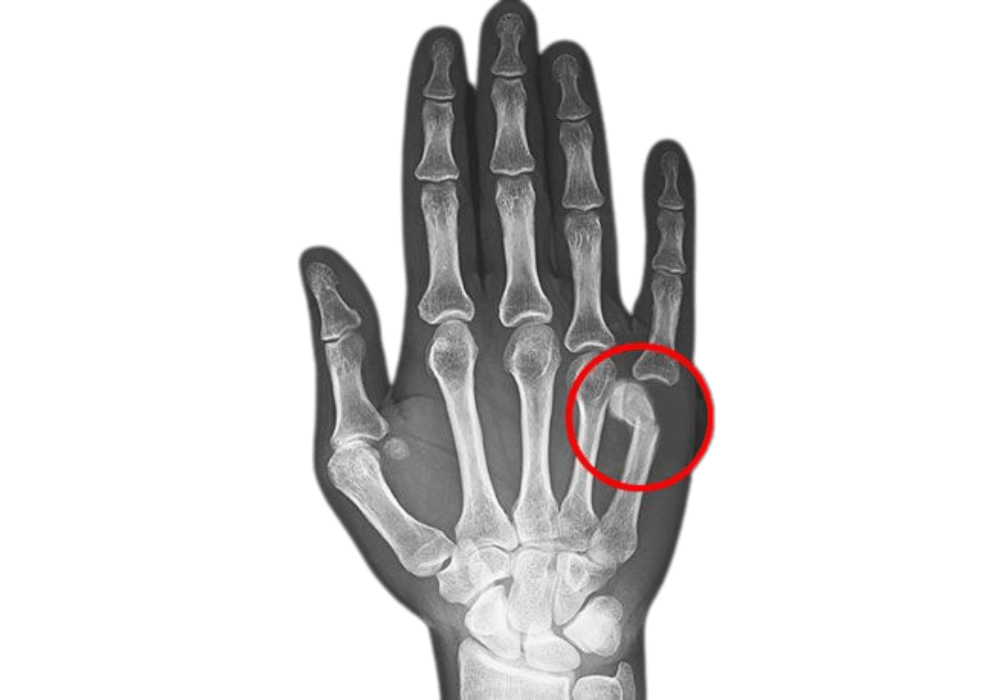At Apex sports Clinic, Our patients with boxer’s fracture are treated well in Singapore, also known as a metacarpal fracture, specifically refers to a break in the neck of the fifth metacarpal bone, which is located in the hand just below the pinky finger. This injury is frequently seen in athletes, especially those involved in sports that involve punching or striking with a closed fist, such as boxing, martial arts, and even football.

A boxer's fracture, also known as a metacarpal fracture, specifically refers to a break in the neck of the fifth metacarpal bone, which is located in the hand just below the pinky finger.
A boxer’s fracture occurs when there is a break in the neck of the fifth metacarpal bone. This type of fracture is typically the result of a direct impact or forceful strike to a solid object. The name “boxer’s fracture” comes from its common occurrence in boxers, but it can happen to anyone who punches a hard surface or sustains a direct blow to the hand.
The most common cause of a boxer’s fracture is a direct impact to the hand, usually from punching a hard object or falling onto a clenched fist. Athletes in sports such as boxing, martial arts, and even football are at risk due to the high likelihood of striking hard surfaces or opponents. Falling onto an outstretched hand or sustaining a blow during physical activities can also result in this type of fracture.



Immediate pain and tenderness at the site of the fracture, typically along the outer side of the hand.
Noticeable swelling and bruising around the injured area, which may spread to other parts of the hand.
The affected finger may appear misaligned or shortened, and the knuckle may seem flattened.
Difficulty moving the affected finger and hand, with significant pain during any attempt to grip or make a fist.
In some cases, there may be numbness or tingling in the hand due to nerve involvement.
For athletes and individuals with a boxer’s fracture, surgical intervention may be necessary, especially in cases where the fracture is displaced or severe. Here’s a detailed look at the surgical treatments available:
Closed Reduction and Immobilization
Procedure:
Closed reduction is a non-invasive procedure where the orthopedic surgeon manually realigns the fractured bone without making any incisions. This technique is used when the bones have shifted out of place but can be manipulated back into their proper alignment. Once the bones are realigned, the hand is immobilized using a cast or splint. The immobilization device extends from the fingers to the forearm, keeping the fractured bone stable and allowing it to heal properly.
Follow-Up:
Regular follow-up appointments are essential to monitor the healing process. X-rays may be taken periodically to ensure the bones remain in the correct position.
Benefits:
Considerations:
Open Reduction and Internal Fixation (ORIF)
Procedure:
ORIF involves making an incision over the fracture site to directly visualize and access the broken bones. This approach is chosen for more severe fractures or when closed reduction is not sufficient to achieve proper alignment.The surgeon carefully realigns the fractured bone fragments. This precise alignment is crucial for proper healing and restoring normal function. In order to maintain the alignment, the surgeon uses hardware such as plates, screws, or wires to secure the bones. These devices hold the bone fragments in place, providing the stability needed for healing. After securing the bones, the incision is closed with sutures or staples. The hand is then immobilized in a cast or splint to protect the repair.
Benefits:
Considerations:
After surgery, the hand is immobilized using a cast or splint to protect the repair and facilitate proper healing. It is crucial to avoid putting stress on the healing bone, which includes refraining from lifting heavy objects or engaging in activities that could disrupt the repair.
A structured physical therapy program is essential to restore strength, flexibility, and range of motion. Therapists will guide patients through exercises tailored to their specific needs. Gradually reintroducing activities and sports is vital, with a focus on preventing reinjury. Athletes may need to modify techniques or use protective gear during their return to sports.
Regular follow-up visits with the orthopedic surgeon ensure that the healing process is progressing as expected. X-rays may be taken to confirm the bone is healing correctly.
Key Takeaway
Surgical treatments for a boxer’s fracture, whether through closed reduction or ORIF, aim to restore proper alignment and function to the injured hand. The choice of procedure depends on the severity of the fracture and the specific needs of the patient. Post-surgical management, including immobilization, rehabilitation, and monitoring, is crucial for a successful recovery. Athletes and individuals should follow their healthcare provider’s recommendations to ensure a smooth return to their daily activities and sports.
For more information or to schedule a consultation, visit Apex Sports Clinic. We’re dedicated to helping you heal and get back to your game.
Elevate your performance with Apex Sports Clinic! Schedule an appointment today for personalized, expert care in optimizing your athletic potential.


